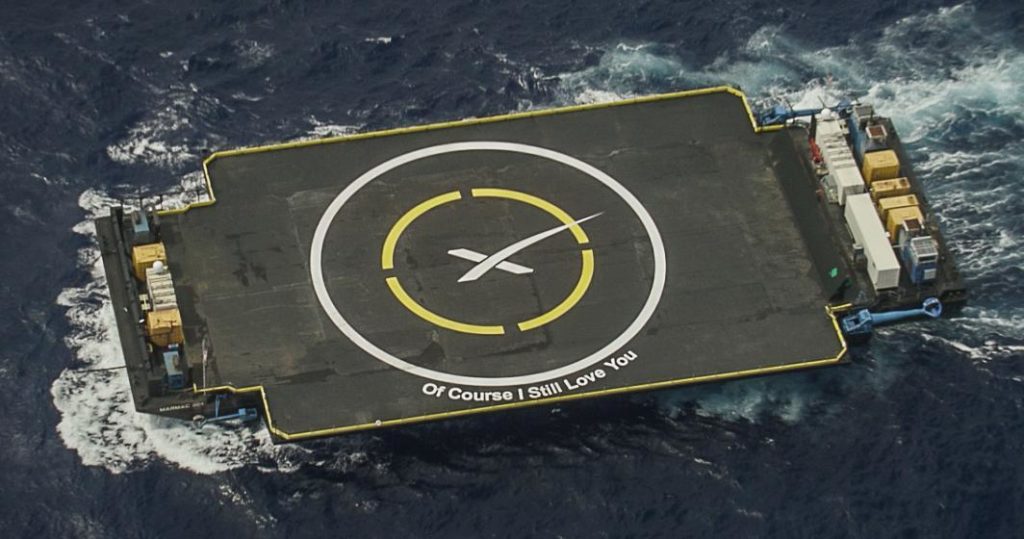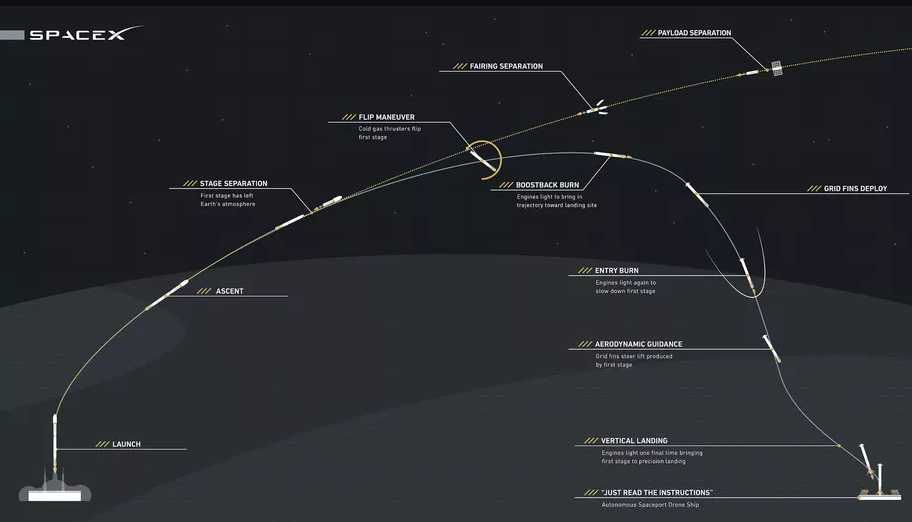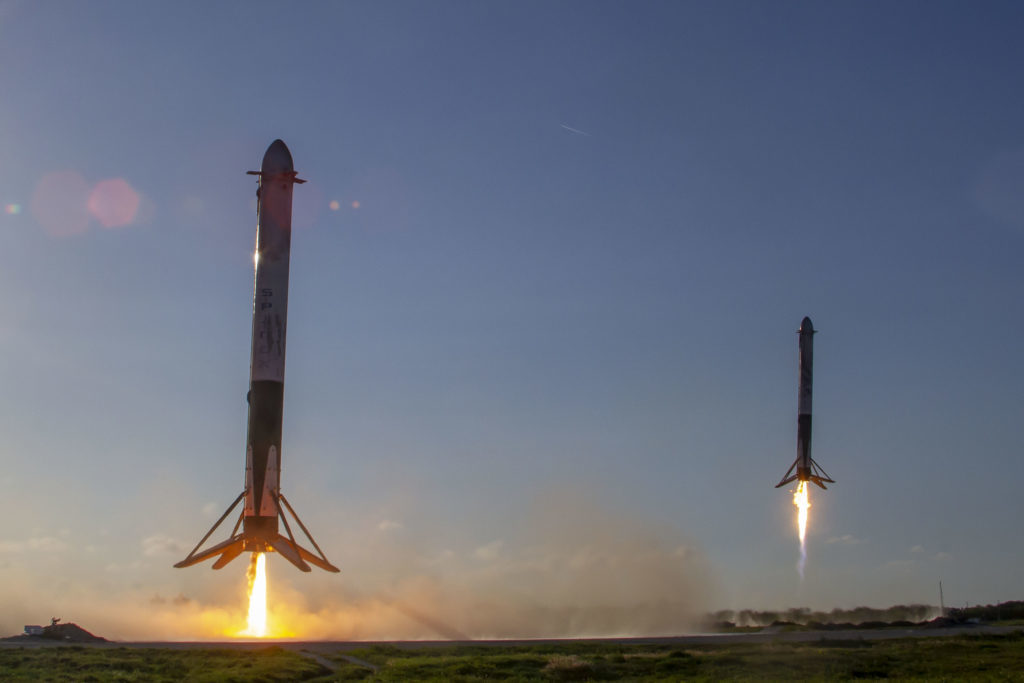For the past decade, the entire world had their eyes on SpaceX as they have revolutionized rocket engineering and space travel.
From launching a sports car into orbit, to the promise of establishing a futuristic colony on mars, their spectacles have generated levels of public excitement and media coverage that haven’t been seen since NASA’s Apollo program which ended more than 40 years ago.
At the core of their ambitious plans is one of the greatest technological developments in the history of rocket engineering: reusable rockets.
First announced to the public in 2011, the SpaceX reusable launch system development program set out to create a new generation of launch vehicles that would drastically reduce the cost of reaching orbit.
To accomplish this, SpaceX proposed the seemingly impossible task of recovering rocket boosters using powered-descent.
Their goal was to develop a rocket that could be launched vertically to deliver a payload into orbit, and then return back to earth with a controlled descent and vertical landing at a pre-determined landing site.That can be either on land, or on an autonomous floating drone ship.

In just 7 years, SpaceX was not only able to achieve their goal of creating such a rocket, but they have proven that their system is both reliable and economical with more than 60 successful launches and 30 successful landings of their Falcon 9 boosters, along with a 100% success rate since the completion of their experimental testing program or at least that was the case until December 2018, but at least they had a pretty good run.
17 of their boosters were also re-used on successive missions, and their unit cost for launching a kg of payload into orbit has been reduced to just a fraction of the nearest competitor.
But how exactly did SpaceX accomplish this, and how do they manage to land 70 m tall rockets weighing in excess of ½ a million kilograms precisely on a 50 m wide landing pad after they are launched more than 70 km into the atmosphere at speeds exceeding 8,000 km/h?
It all comes down to just 2 key things,
- Experience
- Ridiculously well-engineered rockets.
Experience
Let’s start with experience by taking a brief look at the history of the reusable launch system development program.
The program itself was first announced in 2011, but it wasn’t until late 2015 that SpaceX was able to land a Falcon 9 booster on land successfully, and it took several years beyond this to achieve a respectable landing success rate.
Before this, SpaceX spent 5 years conducting experimental landings where they tested their new technologies and learned how to build better rockets through trial and error.
They began with a prototype vertical takeoff and vertical landing vehicle called Grasshopper, which completed 8 successful flights from 2012 to 2013.
Following the initial success of Grasshopper, SpaceX then equipped their first Falcon 9 boosters for powered-descent and conducted several soft landings on the ocean surface from 2013 to early 2015.
Unfortunately, these first tests with the Falcon 9 were only able to achieve a landing accuracy of about 10 km, but this was greatly improved in future tests.
When the first landings on an autonomous floating drone ship were attempted later in 2015, SpaceX endured a series of public failures as 4 consecutive landings failed quite dramatically.
Despite these failures, they obtained valuable data from every single flight, and they used the failures as opportunities to learn from their mistakes in order to develop a more robust landing system.
Falcon 9 first stage on our droneship in the Atlantic after propelling the Dragon spacecraft to the @Space_Station pic.twitter.com/Cnnej7zEnt
— SpaceX (@SpaceX) April 8, 2016
SpaceX continued to perform Falcon 9 landing tests through 2015 and 2016, both on drone ships and on land, and successful landings became routine by early 2017, with SpaceX deciding to stop referring to their landing attempts as experimental.
From the beginning of 2017 to nearly the end of 2018, SpaceX maintained a 100% landing success rate with a minimum landing accuracy of just 10 m.
This impressive accuracy represents a 1000-fold improvement compared to the initial soft-landing tests which were only able to land within a 10 km radius from the intended target.
But how did SpaceX manage to increase the landing accuracy of their rocket boosters by 10,000% in just 4 years?
Obviously, this wasn’t achieved through experience alone, and so this brings us to point number,
Ridiculously well-engineered rockets.
When SpaceX performs a rocket launch with the Falcon 9, the rocket separates into two stages in Earth’s upper atmosphere.
The second stage of the rocket carries the payload into space, while the first stage booster returns to Earth and lands at a landing site for re-use.

The booster is programmed to follow a precise flight path back to Earth, and it must autonomously perform a series of controlled maneuvers in order to maintain that path and land vertically on the landing pad.
The exact flight path depends on whether the rocket is landing on a floating drone ship in the ocean, or on land, and for landings at sea there is the added complexity of ensuring that the drone ship is in the correct position when the rocket touches down.
However, the greatest engineering challenge by far is building a rocket capable of performing the maneuvers that are necessary for controlled descent and landing.
After stage separation occurs, the rocket booster re-orients itself and performs a boost back burn to achieve the proper trajectory towards Earth.
During the descent, it performs a re-entry burn which is used to reduce its velocity.
As the booster approaches the landing site, it re-orients itself again so that it is in line with the landing pad, it deploys its landing legs, and it performs a landing burn to bring its velocity to zero as it touches down on the pad.

During the entire flight, from stage separation to landing, the rocket continuously measures its orientation and velocity, and it adjusts its trajectory accordingly so that it maintains the correct flight path.
To accomplish all of this, SpaceX has implemented several rocket technologies that were developed and refined through their experimental testing program, and it’s these technologies that have been pivotal to the development of their reusable high-accuracy rockets.
The six key technologies incorporated into the Falcon 9 rocket booster are as follows:
1) Thrust vector control: The merlin rocket engines of the first stage booster are gimbaled using hydraulic actuators so that the direction of thrust can be adjusted.
This is a method of thrust vectoring that can be used to control the orientation of the rocket both within Earth’s atmosphere and outside of Earth’s atmosphere where aerodynamic control surfaces such as fins are ineffective.
Thrust vectoring is actually a common technology that is used for rockets, as well as military aircraft and missiles, however it is absolutely necessary for the maneuverability of the Falcon 9.
2) Cold gas thrusters: The Falcon 9 is equipped with a total of 8 nitrogen cold gas thrusters that are mounted towards the top of the first stage.
There is 1 pod on each side of the rocket, each containing 4 thrusters. Like the gimbaled main engines, the cold gas thrusters are used to control the orientation of the rocket.
They are particularly useful for the flip maneuver after stage separation because of the large lever arm between the thrusters and the rocket’s center of mass.
They are also used to control the rocket at times during flight when the gimbaled main engines are shut off.
3) Re-ignitable engines: Since the first stage must perform three separate burns after stage separation, it is necessary for the main rocket engines to be re-ignitable.
The engines of the first stage booster have therefore been designed so that they can re-ignite in the upper atmosphere at supersonic speeds as well as in the lower atmosphere at transonic speeds.
4) Inertial navigation and global positioning systems: The Falcon 9 is equipped with an inertial navigation system, or INS, that uses several types of sensors to measure the position, orientation, and velocity of the vehicle.
A global positioning system, or GPS, is also used to measure geolocation. The onboard computer receives data from the INS and GPS in real-time and checks this information against the pre-programmed flight path.
If the computer detects any deviations from the flight path, then it instructs the rocket to adjust its orientation and velocity as necessary.
5) Deployable landing gear: In order to perform vertical landings, the Falcon 9 is equipped with 4 lightweight landing legs that are deployed using high-pressure helium just before touchdown.
Each leg is constructed from carbon fiber and aluminum, and contains an impact attenuator for particularly hard landings.
The total span of the deployed landing gear is approximately 18 m, and the entire landing system weighs less than 2,100 kg.
6) Deployable grid fins: Four titanium grid fins are mounted at the top of the first stage booster, and are deployed during the rocket’s descent back into Earth’s lower atmosphere.
The fins are aerodynamic control surfaces that are used for precise control of the rocket’s position and orientation prior to landing.
The 4 grid fines alone are primarily responsible for the incredible 10 m landing accuracy of the Falcon 9 first stage booster.
Grid fins were first used on the fifth soft-landing attempt of the reusable launch system development program in 2015, and iterations on their design were continued through 2017 in order to achieve the accuracy that we see from SpaceX today.
So, in the end, SpaceX was able to employ experience and good engineering to develop a reusable and highly accurate launch vehicle.
The Falcon 9 and Falcon Heavy is an astonishing feat of modern engineering.
Read how NASA’s car size Perseverance Rover lands on Mars here.
Additional Resources:
- SpaceX
- Wikipedia
